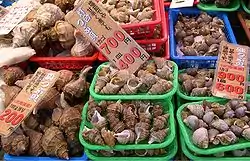螺
| ||||||||
| ||||||||
Translingual
Han character
螺 (Kangxi radical 142, 虫+11, 17 strokes, cangjie input 中戈田女火 (LIWVF), four-corner 56193, composition ⿰虫累)
References
- KangXi: page 1095, character 12
- Dai Kanwa Jiten: character 33512
- Hanyu Da Zidian (first edition): volume 4, page 2885, character 5
- Unihan data for U+87BA
- Unihan data for U+F911
Chinese
| simp. and trad. |
螺 | |
|---|---|---|
| alternative forms | 蠃 | |
Glyph origin
| Old Chinese | |
|---|---|
| 摞 | *roːl, *roːls |
| 騾 | *roːl |
| 螺 | *roːl |
| 蔂 | *roːl, *rul |
| 虆 | *roːl, *rul |
| 瘰 | *roːlʔ |
| 礌 | *ruːl, *ruːls |
| 雷 | *ruːl |
| 擂 | *ruːl, *ruːls |
| 攂 | *ruːl, *ruːls |
| 礧 | *ruːll, *ruːlʔ, *ruːls |
| 儡 | *ruːl, *ruːlʔ, *ruːls |
| 瓃 | *ruːl, *rul, *ruls |
| 櫑 | *ruːl, *ruːlʔ |
| 鑘 | *ruːl, *ruːlʔ |
| 鐳 | *ruːl |
| 畾 | *ruːl |
| 轠 | *ruːl, *rulʔ |
| 罍 | *ruːl |
| 蕾 | *ruːlʔ |
| 癗 | *ruːlʔ |
| 磥 | *ruːlʔ |
| 累 | *ruːls, *rolʔ, *rols |
| 儽 | *ruːls, *rul |
| 樏 | *rolʔ, *rul |
| 鸓 | *rul, *rulʔ |
| 嫘 | *rul |
| 纍 | *rul, *ruls |
| 欙 | *rul |
| 纝 | *rul |
| 壘 | *rulʔ |
| 櫐 | *rulʔ |
| 蘽 | *rulʔ |
| 藟 | *rulʔ |
| 讄 | *rulʔ |
Phono-semantic compound (形聲, OC *roːl) : semantic 虫 + phonetic 累 (OC *ruːls, *rolʔ, *rols).
Etymology
From Proto-Sino-Tibetan *kroj (“shellfish, shell”). From the same root derives 蝸 (OC *kroːl, *kʷroːl, “terrestrial snail”).
Pronunciation
Definitions
螺
- aquatic snail (as opposed to a terrestrial snail, 蝸/蜗 (wō))
- whorl; swirl; spiral
- fingerprint whorls
- (organic chemistry) spiro-
- (transgender slang) Short for 螺內酯/螺内酯 (luónèizhǐ, “spironolactone”); spiro
- (historical) wine cup made from a snail shell
- (historical) ink; pigment (green-black in color, produced from the snail, and used by women for drawing eyebrows)
- Short for 螺髻 (“hair done up in a coil shape”).
Compounds
|
References
- “螺”, in 漢語多功能字庫 (Multi-function Chinese Character Database), 香港中文大學 (the Chinese University of Hong Kong), 2014–
- “Entry #12384”, in 臺灣閩南語常用詞辭典 [Dictionary of Frequently-Used Taiwan Minnan] (in Chinese and Min Nan), Ministry of Education, R.O.C., 2011.
Japanese
Readings
Derived terms
- 螺階 (rakai): a spiral staircase
- 螺子 (rashi): a screw (more commonly read as neji)
- 螺旋 (rasen): a spiral
- 螺鈿 (raden): mother of pearl
- 螺杯 (rahai), 螺盃 (rahai): a drinking cup made from the shell of a Turbo marmoratus or green turban snail
- 螺髪 (rahotsu): one of the thirty-two different appearances of Buddha, shown in statuary with a hairstyle consisting of knobby spirals of hair
- 螺髻 (rakei): a hairstyle with the hair wrapped up in a spiral bun similar in shape to a conch shell; a high, verdant mountain
Etymology 2
| Kanji in this term |
|---|
| 螺 |
| つび Jinmeiyō |
| kun’yomi |
From Old Japanese. Cognate with 粒 (tsubu, “grain; granule, little roundish bit of something”).[2] May have originally been the standalone form; compare 神 (kamu, bound form, only used in compounds) and 神 (kami, standalone form).
Pronunciation
- IPA(key): [t͡sɨᵝbʲi]
Noun
螺 • (tsubi)
Etymology 3

| Kanji in this term |
|---|
| 螺 |
| つぶ Jinmeiyō |
| kun’yomi |
From Old Japanese. Cognate with 粒 (tsubu, “grain; granule, little roundish bit of something”).[2] May have originally been the combining form; compare 神 (kamu, bound form, only used in compounds) and 神 (kami, standalone form).
Noun
螺 • (tsubu)
- spiral shellfish, especially smaller ones
- edible marine whelks of family Buccinidae
- alternate name for 田螺 (tanishi): river snails of family Viviparidae
Etymology 4
| Kanji in this term |
|---|
| 螺 |
| つみ Jinmeiyō |
| kun’yomi |
/t͡subi/ → /t͡sumi/
Shift in pronunciation from tsubi above.
Pronunciation
- IPA(key): [t͡sɨᵝmʲi]
Etymology 5
| Kanji in this term |
|---|
| 螺 |
| にし Jinmeiyō |
| kun’yomi |
From Old Japanese. Previously referred to any shellfish with a spiral shell (see ra above). Now refers more specifically to certain spiral shellfish. More common in compounds.
Alternative forms
- 辛螺
Derived terms
- 螺肴 (nishizakana): a side dish served at New Years celebrations, made from boiled or stewed 田螺 (tanishi, “river snails of family Viviparidae”)
- 赤螺 (akanishi): Rapana venosa, the veined rapa whelk
- 田螺 (tanishi): river snails of family Viviparidae
- 長螺 (naganishi): tulip snails or spindle snails, marine snails of family Fasciolariidae
- 丸田螺 (marutanishi): Bellamya chinensis or Cipangopaludina chinensis, the Chinese mystery snail, black snail, or trapdoor snail
Etymology 6
| Kanji in this term |
|---|
| 螺 |
| にな Jinmeiyō |
| kun’yomi |
From Old Japanese.
Less common spelling in modern Japanese. When written in kanji, more commonly spelled 蜷.
Alternative forms
- 蜷, 蝸螺, 河貝子
Noun
螺 • (nina)
- shellfish with a spiral shell
- Short for 川蜷. (kawanina): Semisulcospira libertina, a kind of freshwater snail
Derived terms
- 磯蜷 (isonina): a small edible marine snail of family Buccinidae
- 海蜷 (uminina): Batillaria multiformis, a small edible marine snail
- 川蜷 (kawanina): Semisulcospira libertina, a kind of freshwater snail
References
- 2006, 大辞林 (Daijirin), Third Edition (in Japanese), Tōkyō: Sanseidō, →ISBN
- 1988, 国語大辞典(新装版) (Kokugo Dai Jiten, Revised Edition) (in Japanese), Tōkyō: Shogakukan
Korean
Etymology
From Middle Chinese 螺 (MC luɑ). Recorded as Middle Korean 라 (la) (Yale: la) in Hunmong Jahoe (訓蒙字會 / 훈몽자회), 1527.